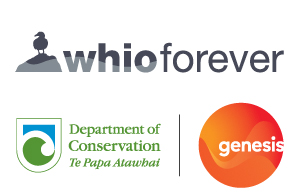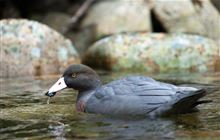Future generations celebrate whio on the Manganui-o-te-Ao river
Archived content: This media release was accurate on the date of publication.
Introduction
Whanganui whio populations in the wild were boosted last month when 16 captive-bred native blue ducks were released on the Manganui o te Ao River at Ferne Pool.Date: 01 March 2018
The whio were from captive rearing facilities at Auckland Zoo, Isaac Conservation and Wildlife Trust, and Pukaha Mount Bruce Trust. They spent the past month at the Whio Hardening Facility in Turangi, getting used to living and feeding on moving water.

Releasing whio. From left: Rufus Bristol, Harata Tetawhero, Kenny Jones, Paora (Baldy) Haitana, Petuere Kiwara
Image: DOC
More than 40 people gathered to celebrate the release of the whio. Twenty-five students from Orautoha School attended the release alongside representatives from iwi, Horizons Regional Council, Auckland Zoo and local landowners.
Kaumatua and iwi leader Paora (Baldy) Haitana said he felt blessed to have his mokopuna Harata Tetawhero participating in the release.
“Having my mokopuna involved was the highlight for me. The joy and excitement she expressed was heart-warming. As kaitiaki of our ancestral lands and natural resources, it is important that we make all efforts to ensure our mokopuna and future generations understand the responsibility to protect at-risk native species and the biodiversity of our distinctive wild landscapes, which are critical to our tribal identity.”
Mr Haitana said that another particular icon for local iwi is the piharau (lamprey eel).
“What was once in abundance was a delicacy for our people. Unfortunately, the piharau is no longer thriving in our waters. Our whānau and hapū would welcome a piharau restoration programme like the successful whio and kiwi recovery projects.”
For her part, Harata said to her grandfather Baldy: “I let the whio go for my koko.”
DOC Senior Biodiversity Ranger Dr Rachael Abbott said whio are being released in groups of two or three in places identified as having no resident breeding pairs. “We hope the whio will settle into these sites and boost the number of breeding pairs next year.”
The Manganui-o-te-Ao and Retaruke rivers are one of eight “whio security sites” which are essential for whio recovery and supported by significant investment from Genesis Energy through the Whio Forever partnership. Whio are protected on the rivers through a network of traps targeting stoats and feral cats.
“The goal of a security site is to achieve protection of 50 breeding pairs,” says Dr Abbott.
“This breeding season we have recorded 29 breeding pairs across the two catchments (14 pairs on the Manganui o te Ao and 15 pairs on the Retaruke and associated streams) with 17 singles and 30 juveniles.”
The Kia Wharite Biodiversity project works to improve the health of 180,000 ha of land in the Whanganui National Park and on private land. This work includes pest and weed control, protecting bush and wetlands and monitoring threatened species such as whio and kiwi.
Background information on whio
- The whio is a threatened species of native duck that is only found in New Zealand’s fast flowing waters. Featured on New Zealand’s $10 note and with an estimated nationwide population of fewer than 3000 birds, whio are rarer than kiwi.
- Whio are adapted to living on fast-flowing rivers so finding whio means you will also find clean, fast-flowing water with a good supply of underwater insects.
- This makes whio important indicators of ecosystem health – they only exist where there are high-quality clean and healthy waterways.
Whio Forever
- Genesis Energy has a strong historic association with whio through the Tongariro Power Scheme and in 2010 this association grew through the establishment of Whio Awareness Month (March).
- Today, Genesis Energy and DOC continue their partnership through the Whio Forever Programme, which aims to secure the future of whio in the wild and ensure New Zealanders understand and value of whio in our rivers.
- The support of Genesis Energy and the work of DOC has enabled the Whio Recovery Plan to be implemented.
Conservation issue
- Whio are eaten by stoats, ferrets and cats, with the largest impact during nesting time when eggs, young and females are vulnerable, and when females are in moult and can’t fly.
- Extensive trapping can manage these predators, and work in key whio habitats by DOC and Genesis Energy on the Whio Forever Project has already seen an increase in whio numbers.
- Whio cannot be moved to predator-free islands like other species because of their reliance on large fast-flowing rivers.
- Pairs occupy approximately 1 km of water – so they need a lot of river to sustain a large population and they fiercely defend their territories, which makes it difficult to put them with other ducks in captivity.
- They are susceptible to flood events which destroy nests, fragment broods and wash away their valued food source.
Contact
Susan Osborne, Senior Community Ranger, Whanganui
Mobile: +64 27 569 0970
Email: sosborne@doc.govt.nz


